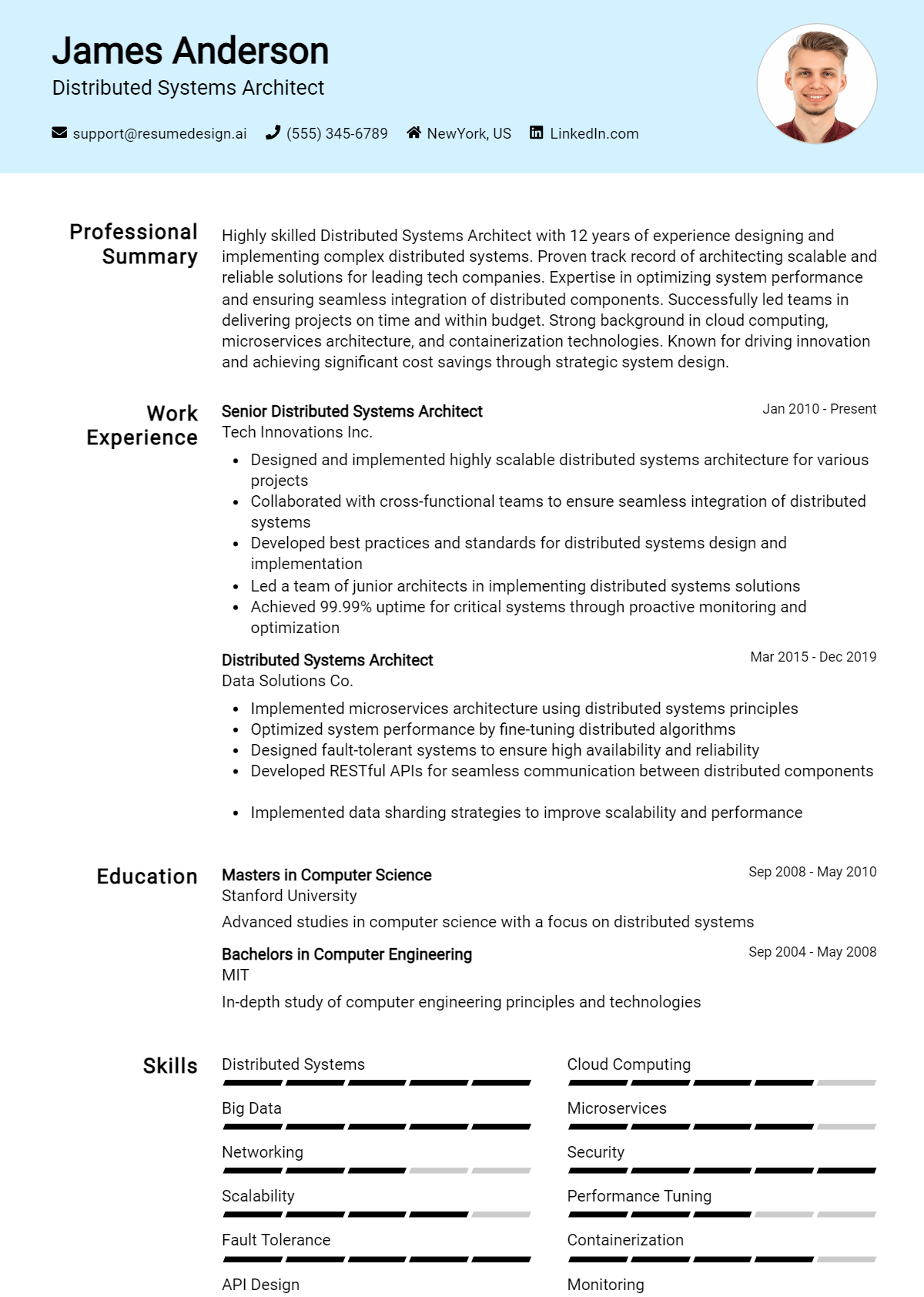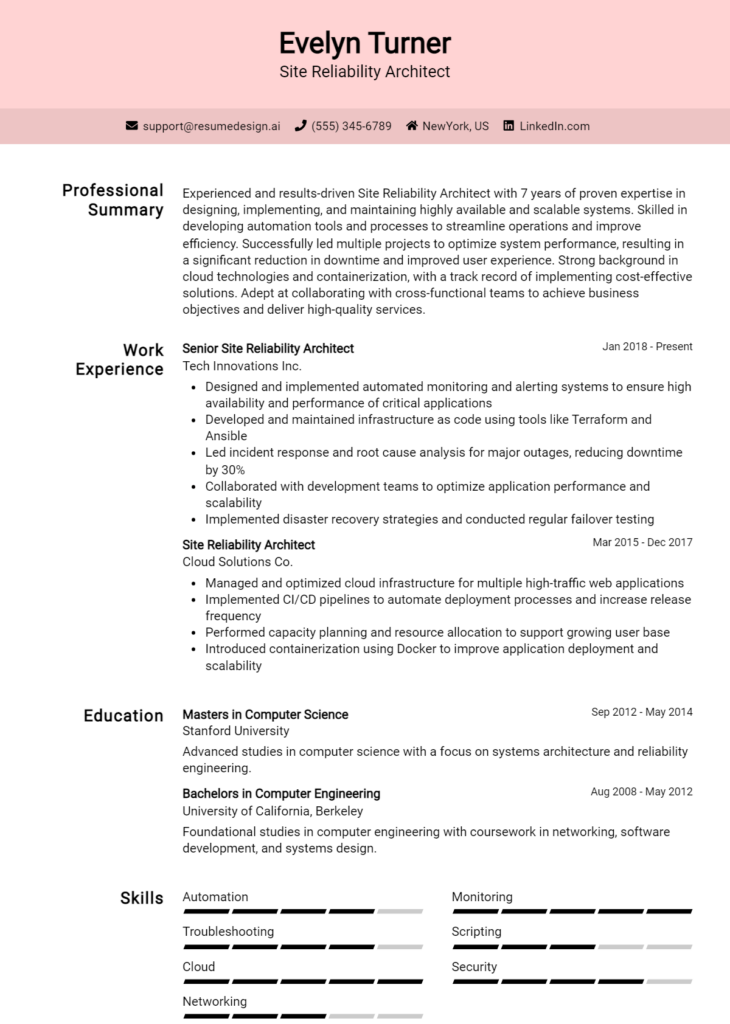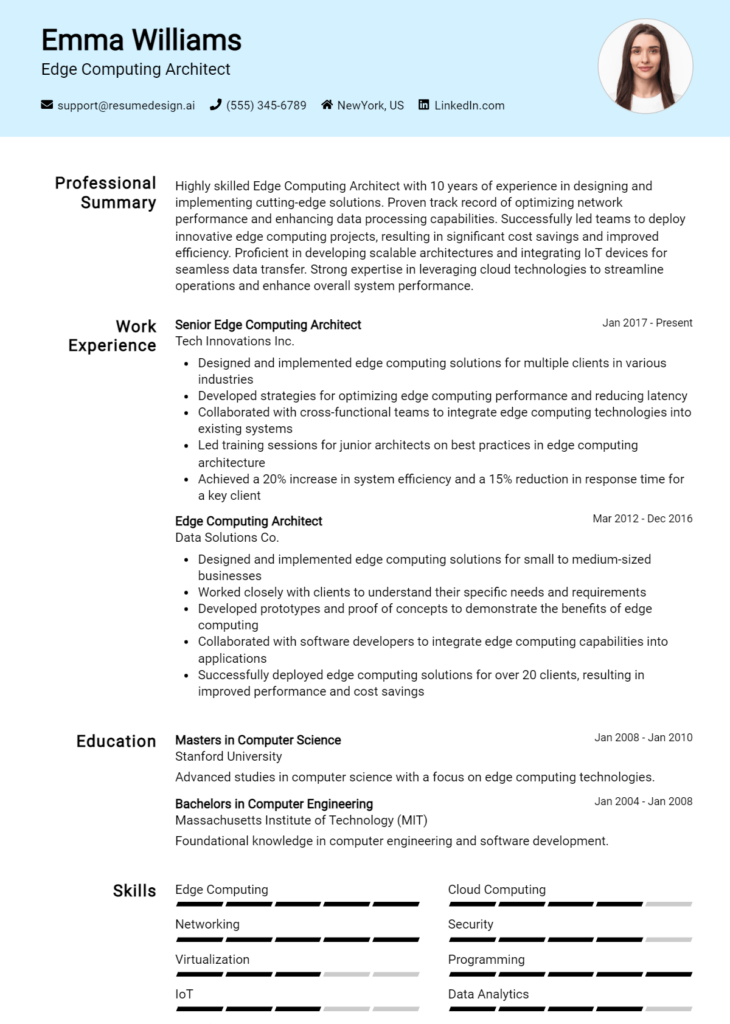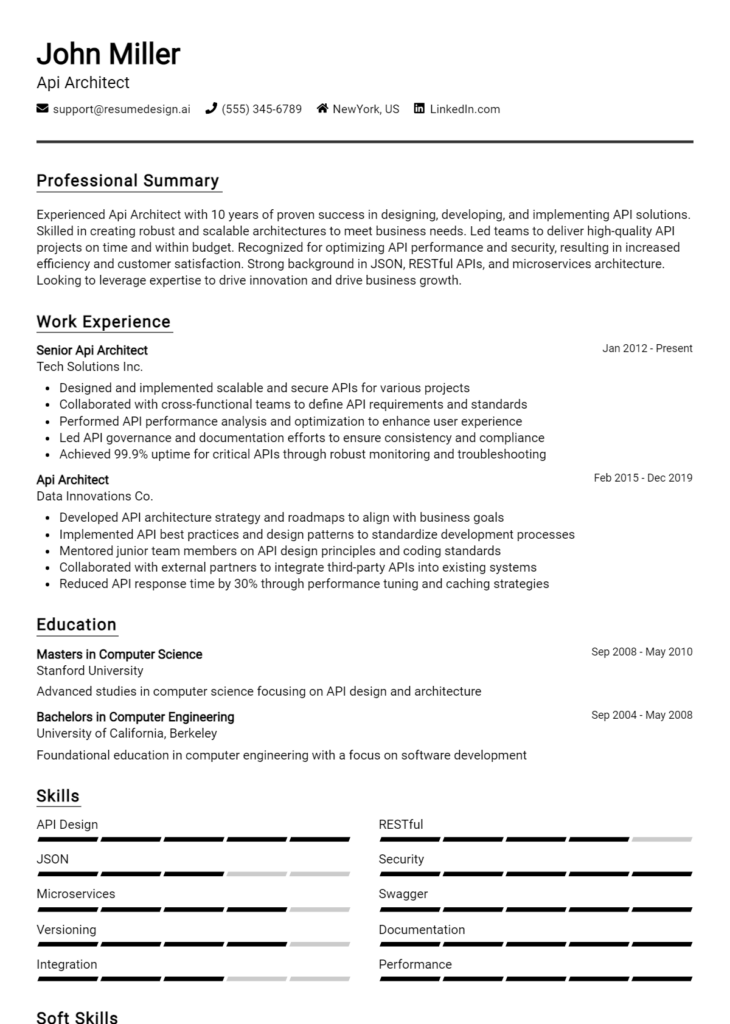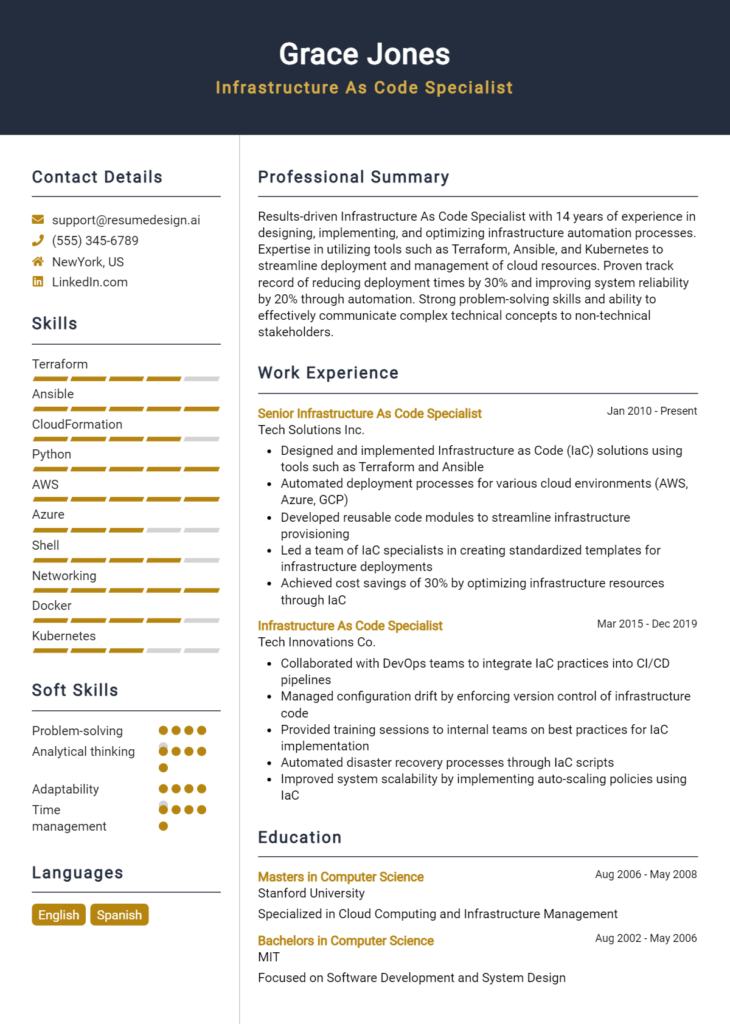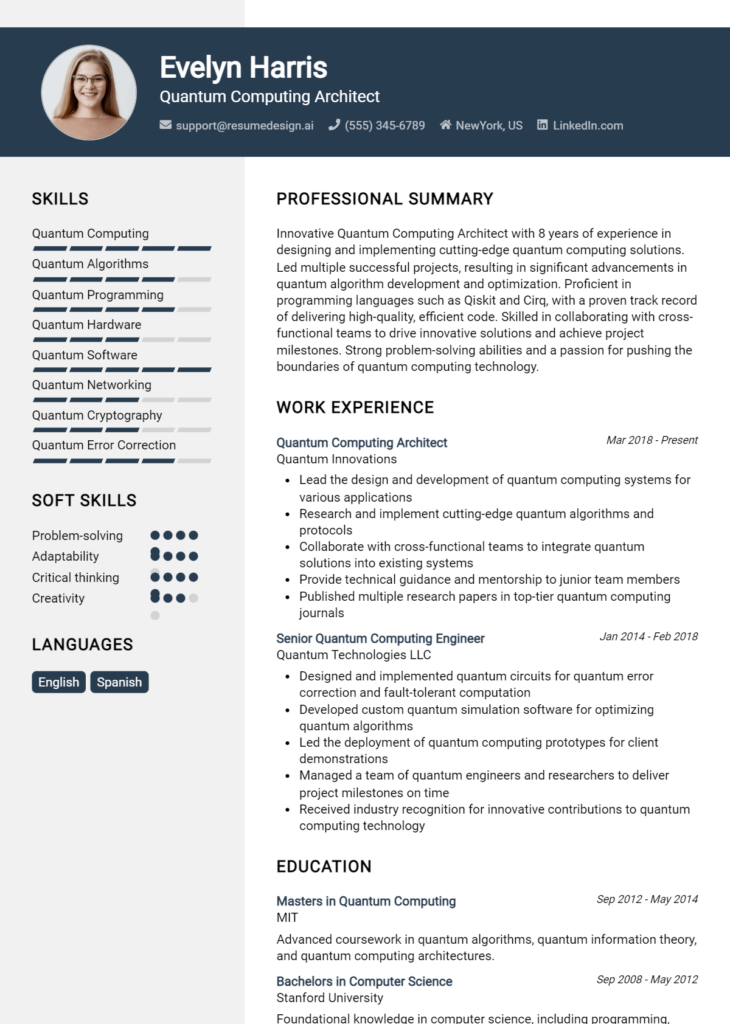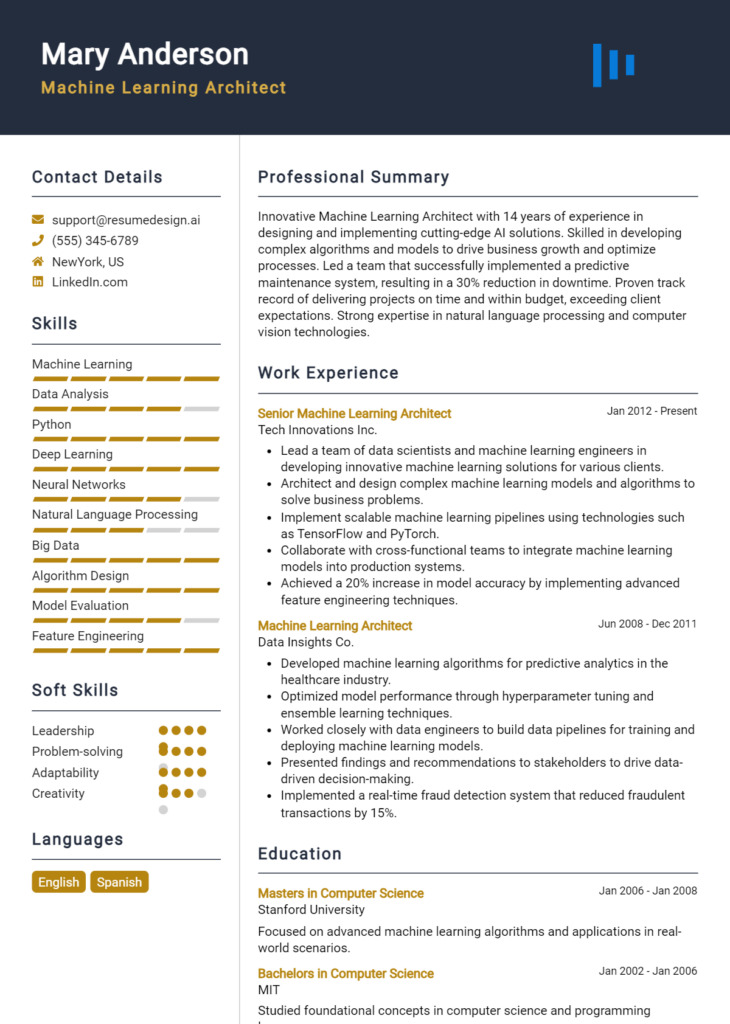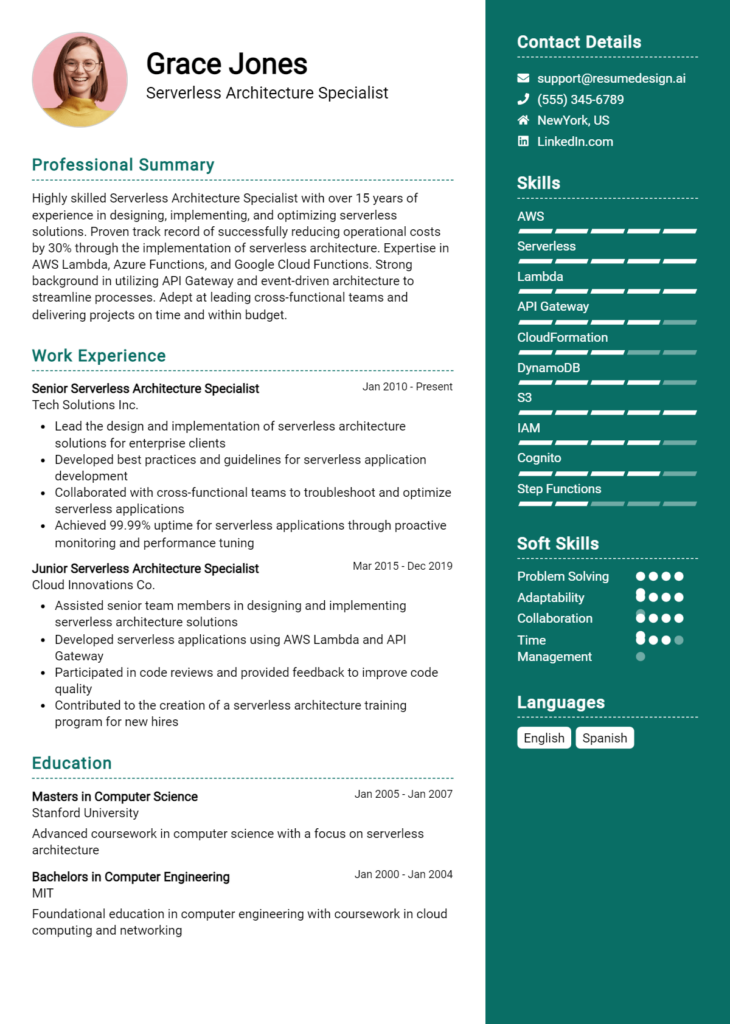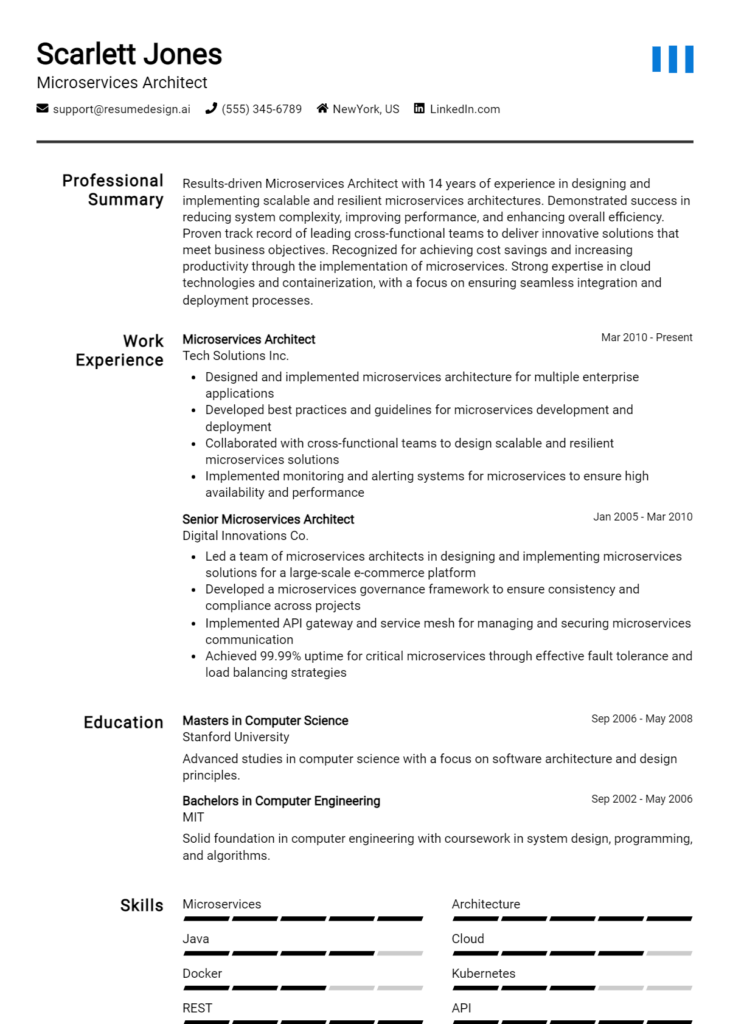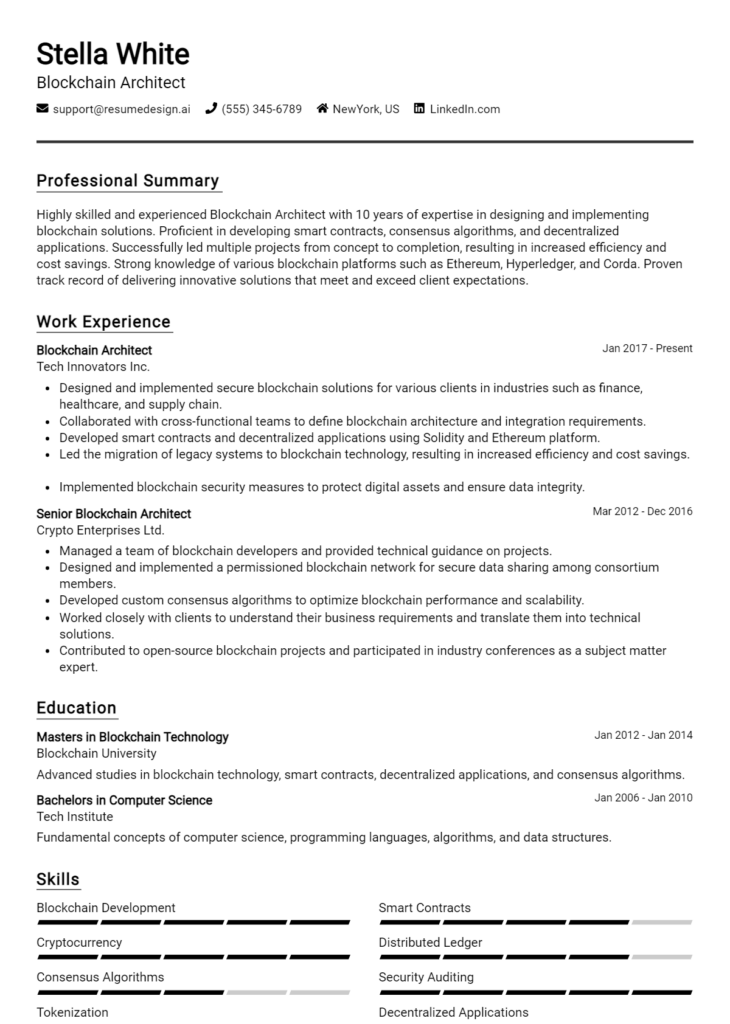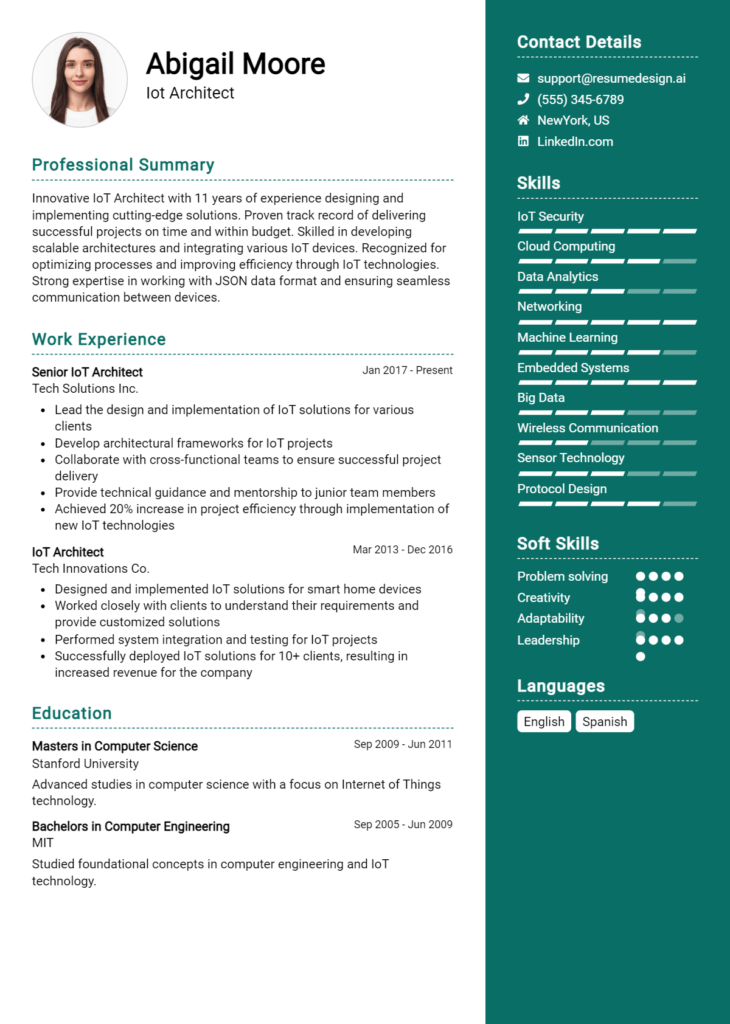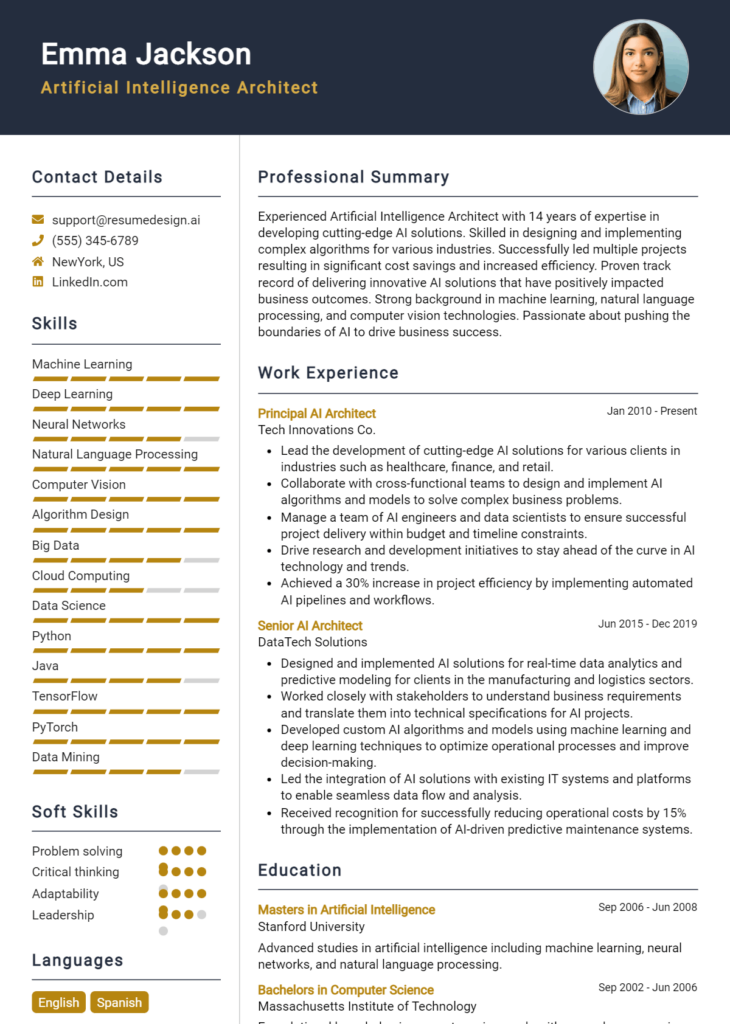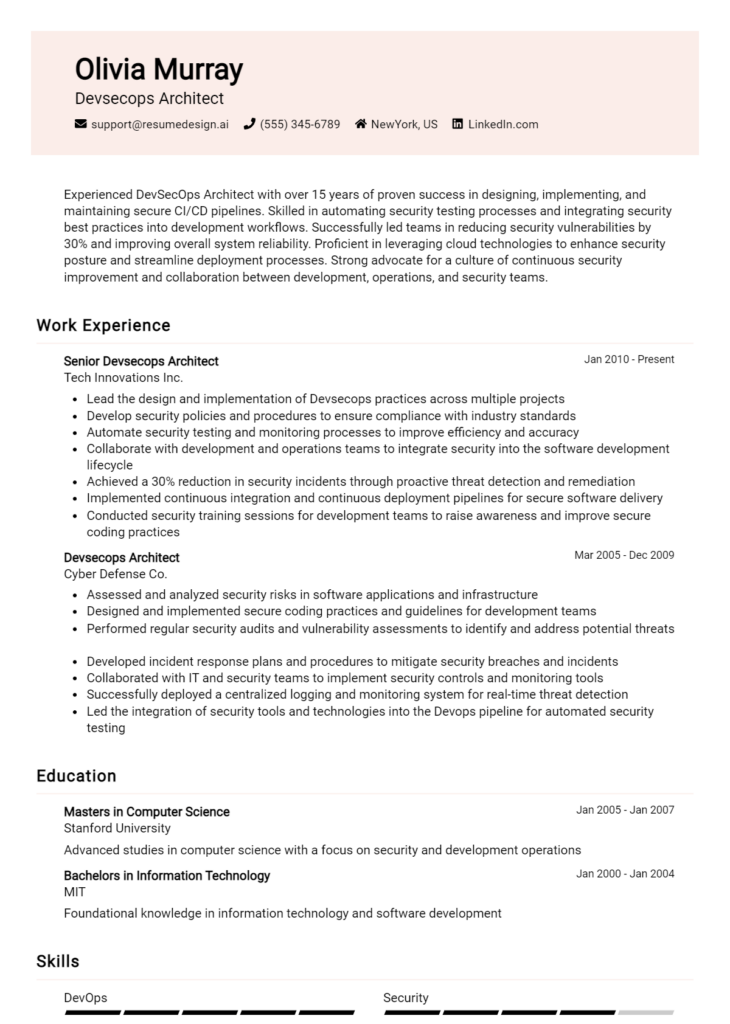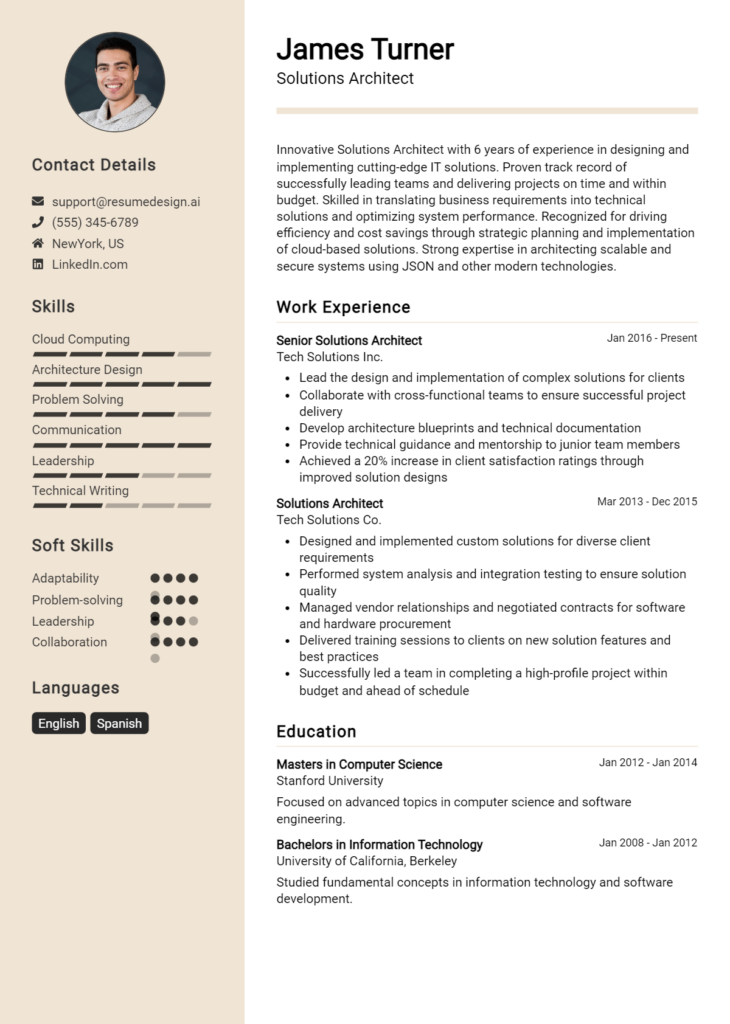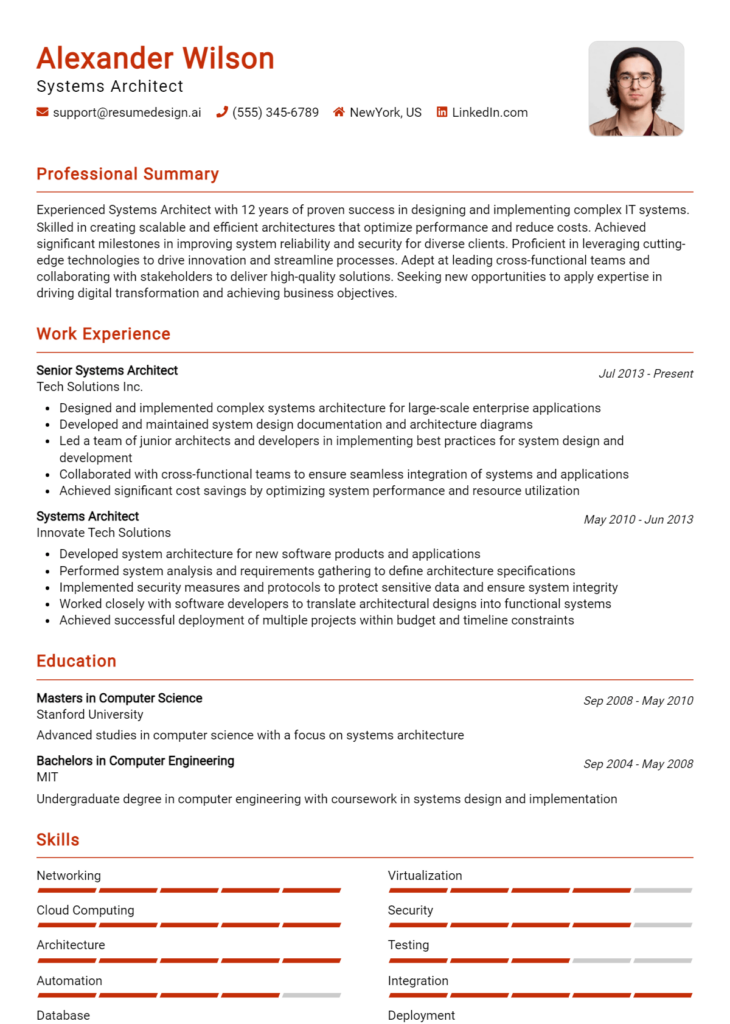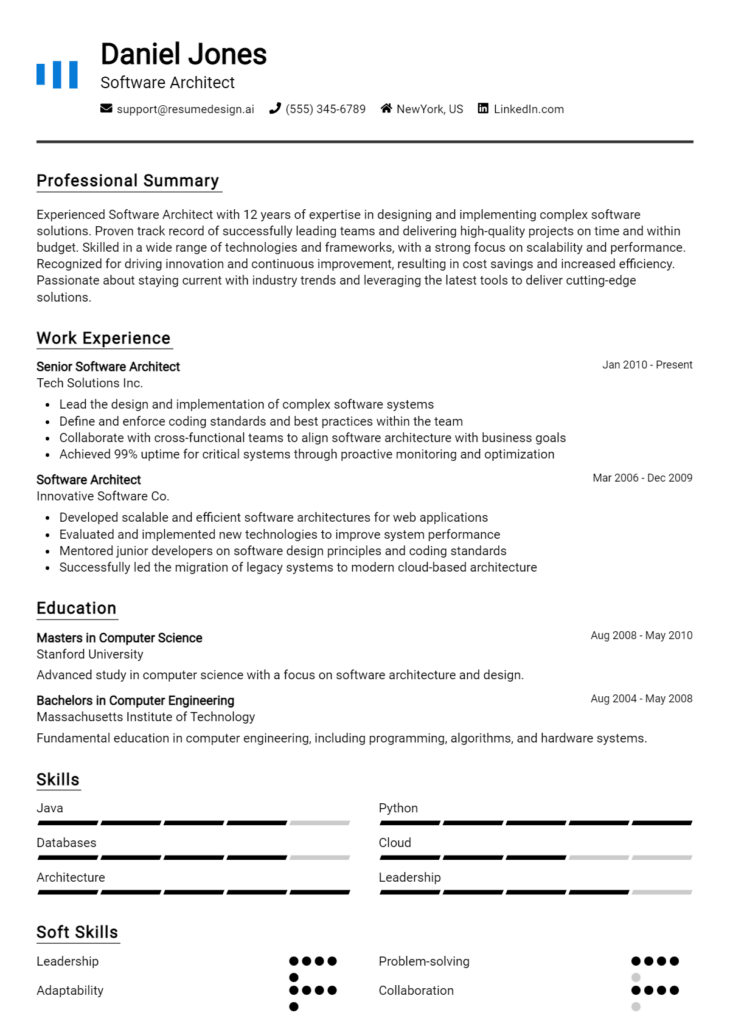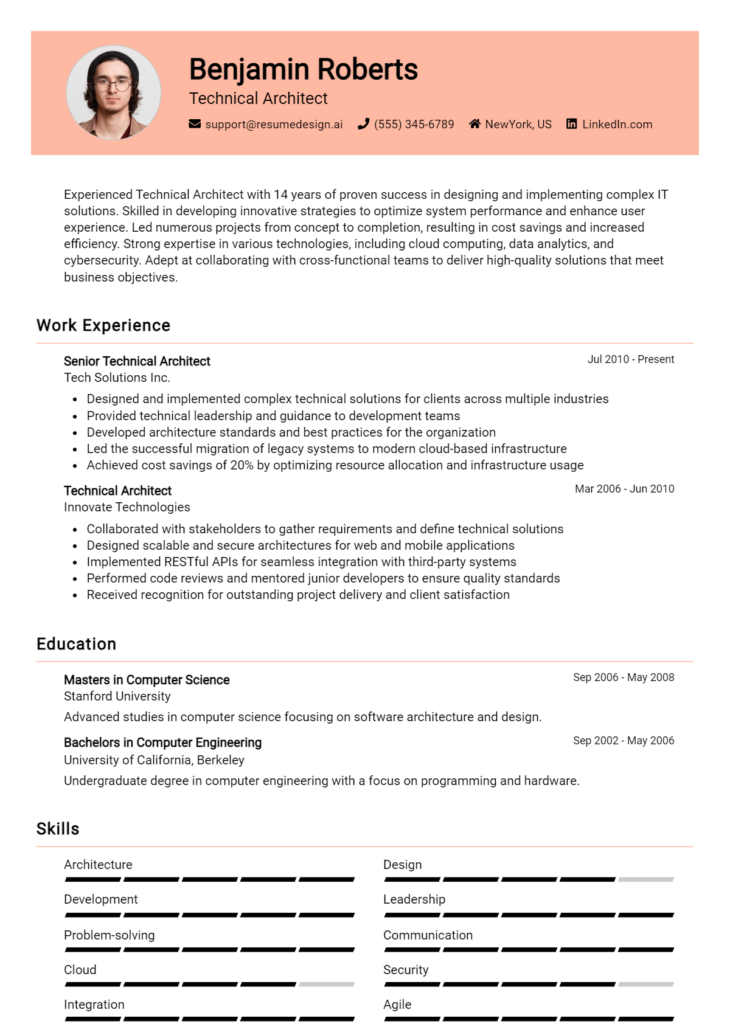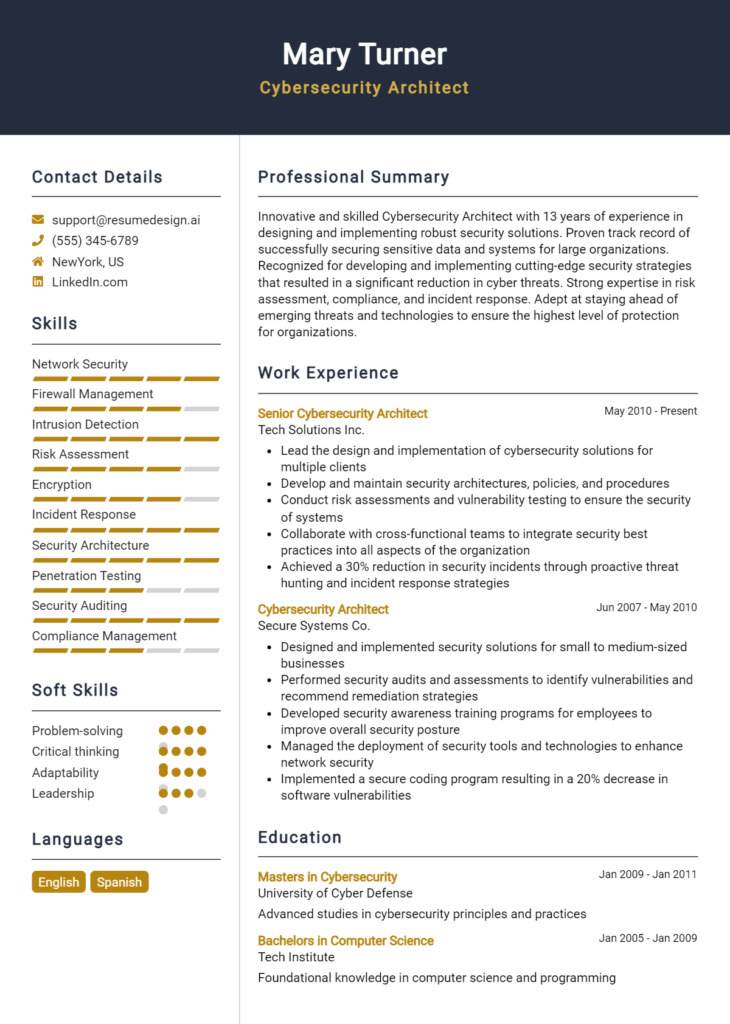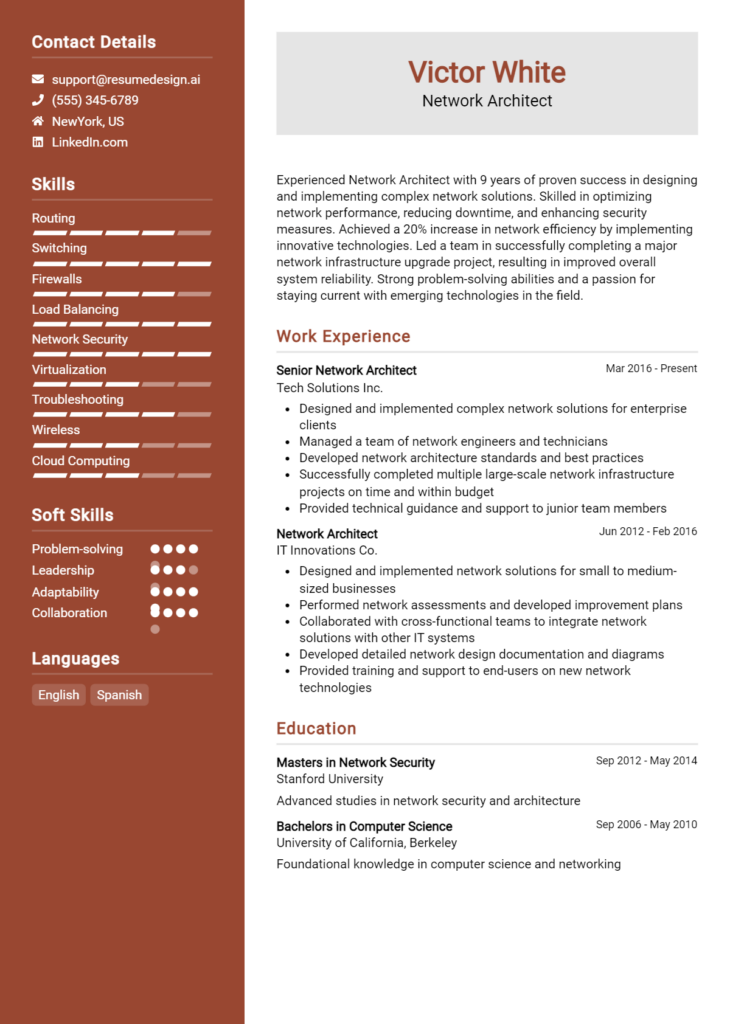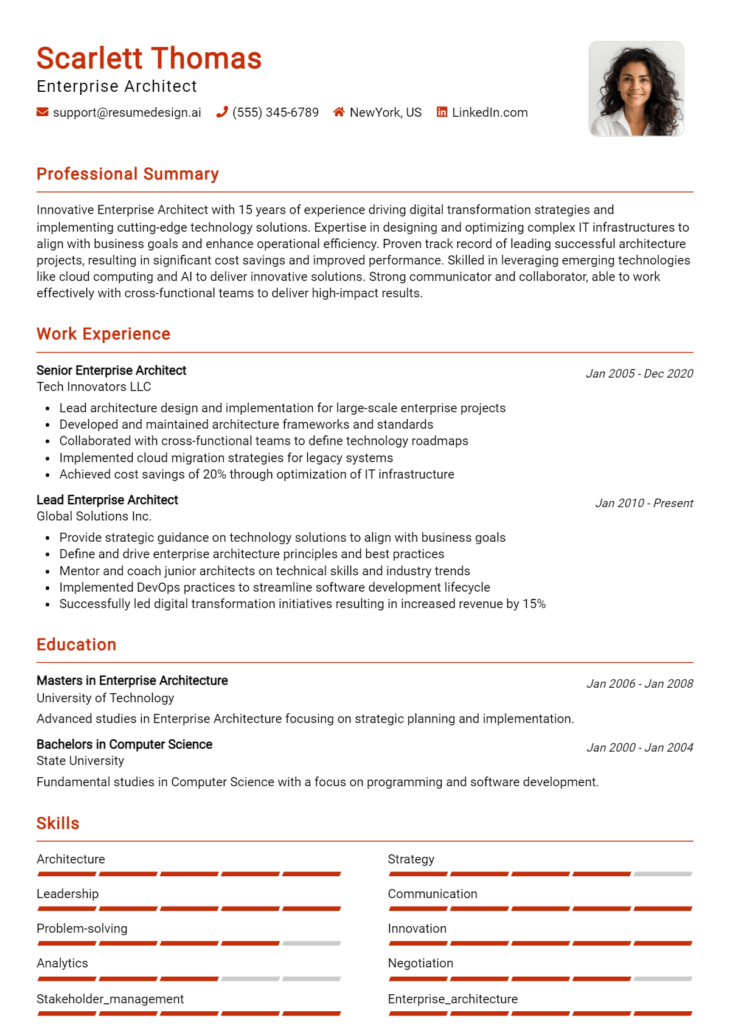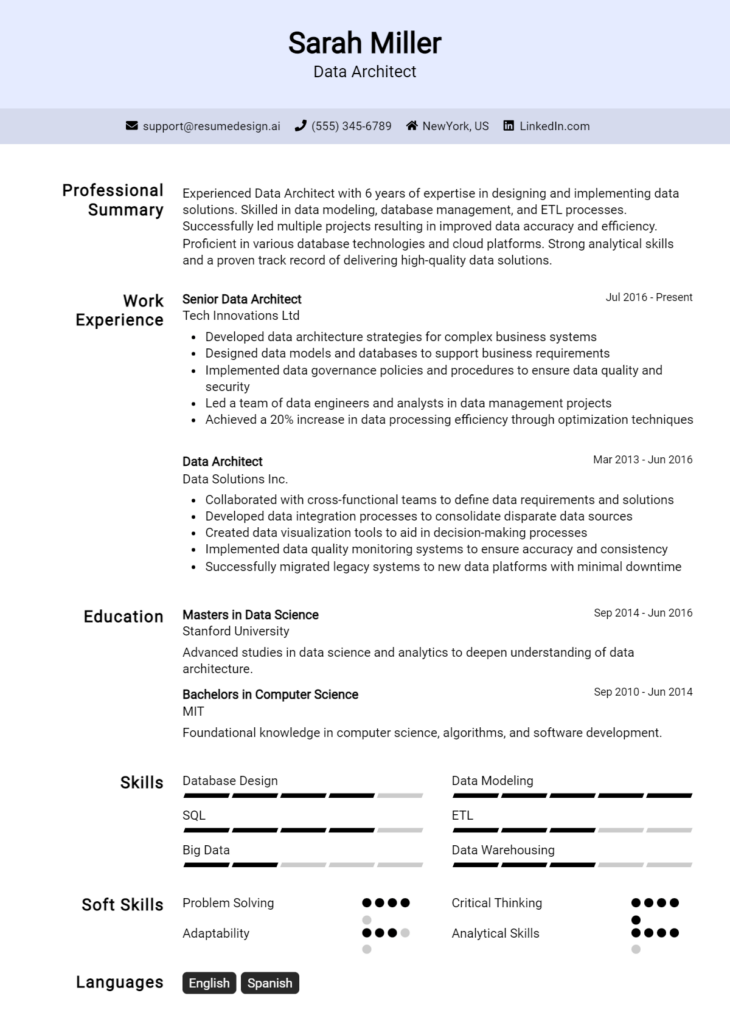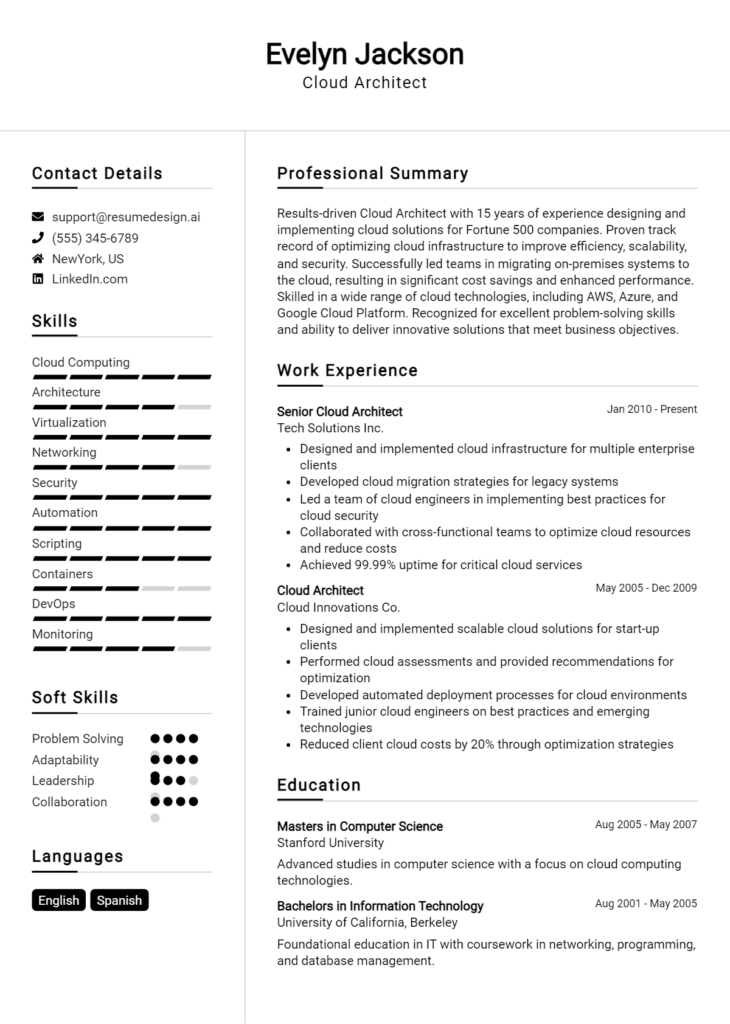Distributed Systems Architect Core Responsibilities
A Distributed Systems Architect is responsible for designing and implementing scalable systems that efficiently handle data across various platforms. This role requires strong technical skills in cloud computing, programming, and system integration, alongside operational expertise to ensure seamless collaboration among departments. Problem-solving abilities are crucial, as architects must anticipate challenges and develop robust solutions. Effectively showcasing these qualifications in a well-structured resume can highlight a candidate's role in driving the organization's strategic objectives.
Common Responsibilities Listed on Distributed Systems Architect Resume
- Designing and implementing distributed system architectures to meet business requirements.
- Collaborating with cross-functional teams to ensure system integration and performance.
- Conducting system analysis to identify bottlenecks and propose optimizations.
- Evaluating and selecting appropriate technologies and tools for system development.
- Ensuring data consistency and availability across distributed environments.
- Documenting system designs, architecture, and processes for reference.
- Monitoring system performance and troubleshooting issues as they arise.
- Participating in code reviews to maintain high-quality standards.
- Staying updated on industry trends and emerging technologies.
- Providing technical guidance and mentorship to junior team members.
- Engaging in capacity planning to ensure scalability and reliability.
- Collaborating with security teams to implement best practices and safeguard data.
High-Level Resume Tips for Distributed Systems Architect Professionals
In today's competitive job market, a well-crafted resume is crucial for Distributed Systems Architect professionals to stand out and make a lasting impression on potential employers. Your resume is often the first point of contact between you and a hiring manager, making it essential to effectively showcase your unique skills, experiences, and achievements in a way that resonates with the demands of the role. This guide will provide practical and actionable resume tips specifically tailored for Distributed Systems Architect professionals, helping you to create a compelling narrative that highlights your qualifications and sets you apart from the competition.
Top Resume Tips for Distributed Systems Architect Professionals
- Tailor your resume for each job application by aligning your skills and experiences with the specific requirements outlined in the job description.
- Showcase relevant experience by detailing key projects and responsibilities that demonstrate your expertise in designing and implementing distributed systems.
- Quantify your achievements wherever possible, using metrics and data to illustrate the impact of your work (e.g., improved system performance by 30% or reduced downtime by 50%).
- Highlight industry-specific skills such as cloud computing, microservices architecture, and container orchestration to show your technical proficiency.
- Include relevant certifications (e.g., AWS Certified Solutions Architect, Google Cloud Professional Architect) to validate your expertise and commitment to the field.
- Utilize action verbs to convey your contributions, such as “designed,” “implemented,” and “led,” which can make your resume more dynamic and engaging.
- Incorporate keywords from the job description to optimize your resume for applicant tracking systems (ATS) and increase chances of getting noticed.
- Keep the format clean and professional, ensuring that your resume is easy to read and navigate, with clear headings and consistent fonts.
- Include a strong summary statement at the top that encapsulates your experience, skills, and career goals in a concise manner.
By implementing these tips, you can significantly enhance your resume's effectiveness, ultimately increasing your chances of landing a job in the Distributed Systems Architect field. A well-structured and tailored resume will not only highlight your qualifications but also demonstrate your understanding of the role and your readiness to tackle its challenges.
Why Resume Headlines & Titles are Important for Distributed Systems Architect
In the competitive field of distributed systems architecture, a well-crafted resume headline or title is crucial for making a positive first impression on hiring managers. A strong headline serves as a powerful summary of a candidate's key qualifications and expertise, allowing them to stand out in a sea of applicants. It should encapsulate essential skills, relevant experiences, and the specific role being targeted, all while being concise and impactful. By doing so, it not only grabs attention but also sets the tone for the rest of the resume, encouraging hiring managers to delve deeper into the candidate's qualifications.
Best Practices for Crafting Resume Headlines for Distributed Systems Architect
- Keep it concise: Aim for a headline that is clear and to the point, ideally no more than 10-12 words.
- Be role-specific: Tailor the headline to reflect the specific position of Distributed Systems Architect you are applying for.
- Highlight key skills: Include relevant technical skills or certifications that set you apart from other candidates.
- Use impactful language: Choose strong, action-oriented words that convey confidence and expertise.
- Incorporate measurable achievements: If possible, include quantifiable results or accomplishments that demonstrate your success in previous roles.
- Avoid generic phrases: Steer clear of vague or overused terms that do not provide specific insights into your qualifications.
- Align with job description: Ensure your headline aligns closely with the language and requirements mentioned in the job posting.
- Maintain professionalism: Ensure your headline reflects a professional tone that is appropriate for the industry.
Example Resume Headlines for Distributed Systems Architect
Strong Resume Headlines
Innovative Distributed Systems Architect Specializing in Cloud Infrastructure and Microservices.
Experienced Architect with a Proven Track Record in Building Scalable Distributed Systems.
Results-Driven Distributed Systems Architect with Expertise in High-Availability Solutions.
Weak Resume Headlines
IT Professional Seeking Opportunities.
Experienced Architect Looking for a Job.
The strong resume headlines are effective because they are specific, highlight relevant skills and experiences, and convey a sense of accomplishment and expertise. They provide clear insights into what the candidate brings to the table, making it easier for hiring managers to assess fit for the role. In contrast, the weak headlines fail to impress because they lack specificity and do not convey any unique qualifications or value propositions, making them forgettable and uninspiring.
Writing an Exceptional Distributed Systems Architect Resume Summary
A well-crafted resume summary is crucial for a Distributed Systems Architect, as it serves as the first impression a candidate makes on hiring managers. This brief yet powerful section quickly captures attention by highlighting key skills, relevant experience, and notable accomplishments tailored to the specific role. A strong summary is concise and impactful, allowing the candidate to stand out in a competitive job market while effectively demonstrating their value to potential employers.
Best Practices for Writing a Distributed Systems Architect Resume Summary
- Quantify achievements to demonstrate impact (e.g., "Reduced latency by 30% in distributed applications").
- Focus on relevant technical skills, such as cloud architecture, microservices, and database management.
- Tailor the summary to align with the specific job description and requirements.
- Highlight specific projects or systems designed to showcase practical experience.
- Use strong action verbs to convey accomplishments and responsibilities effectively.
- Keep it concise, ideally between 3-5 sentences, to maintain the reader's attention.
- Incorporate industry keywords to enhance visibility in applicant tracking systems.
- Showcase soft skills, such as leadership and communication, that complement technical expertise.
Example Distributed Systems Architect Resume Summaries
Strong Resume Summaries
Accomplished Distributed Systems Architect with over 8 years of experience in designing scalable architectures that improved system performance by 40%. Proven expertise in cloud technologies, including AWS and Azure, and a strong background in microservices and container orchestration.
Results-driven Distributed Systems Architect with a track record of leading cross-functional teams to deliver high-availability solutions. Successfully migrated legacy systems to cloud infrastructure, achieving a 25% reduction in operational costs.
Innovative Distributed Systems Architect adept at developing secure and efficient distributed systems. Spearheaded the implementation of a new data synchronization protocol, increasing data accuracy by 50% across multi-region deployments.
Weak Resume Summaries
Experienced architect with knowledge of distributed systems and cloud technologies.
Seeking a position in distributed systems architecture where I can utilize my skills and experiences.
The examples above illustrate the distinction between strong and weak resume summaries. Strong summaries are specific, quantifiable, and directly relevant to the role, showcasing the candidate's achievements and skills in a way that resonates with hiring managers. In contrast, weak summaries lack detail and clarity, making it difficult for employers to assess the candidate's qualifications or potential contributions to the organization.
Work Experience Section for Distributed Systems Architect Resume
The work experience section of a Distributed Systems Architect resume is crucial as it serves as a comprehensive showcase of the candidate's technical prowess, leadership capabilities, and track record of delivering high-quality products. This section not only highlights the specific skills and technologies the candidate has mastered but also illustrates their ability to manage teams effectively and drive projects to successful completion. By quantifying achievements and aligning their experiences with industry standards, candidates can demonstrate their value to potential employers and stand out in a competitive job market.
Best Practices for Distributed Systems Architect Work Experience
- Emphasize relevant technical skills and platforms used in distributed systems.
- Quantify achievements with metrics such as performance improvements, system uptime, and user growth.
- Highlight leadership roles and team management experiences to showcase collaboration abilities.
- Tailor descriptions to match industry standards and terminology for better alignment.
- Include specific projects that demonstrate problem-solving and innovation in distributed system designs.
- Showcase contributions to open-source projects or community involvement to reflect commitment to the field.
- Utilize action verbs to convey a proactive approach and impact in previous roles.
- Ensure clarity and conciseness to maintain the interest of hiring managers and recruiters.
Example Work Experiences for Distributed Systems Architect
Strong Experiences
- Led a team of 10 engineers in the design and implementation of a distributed microservices architecture that improved system scalability by 300% and reduced latency by 40%.
- Architected a cloud-native solution that supported 500,000 concurrent users, resulting in a 50% increase in user satisfaction scores.
- Developed and deployed a distributed data processing pipeline that decreased data processing time from 24 hours to 1 hour, enhancing reporting capabilities significantly.
- Collaborated with cross-functional teams to deliver an enterprise-grade distributed system, achieving 99.99% uptime and receiving an industry award for excellence in system reliability.
Weak Experiences
- Worked on various projects involving distributed systems.
- Participated in team meetings to discuss system architecture.
- Assisted with coding and troubleshooting of distributed applications.
- Helped to improve system performance in an unspecified manner.
The examples provided illustrate the distinction between strong and weak experiences. Strong experiences are characterized by specific, quantifiable results and detailed descriptions of leadership and technical contributions, demonstrating a clear impact on projects and teams. In contrast, weak experiences lack specificity and measurable outcomes, making it difficult to ascertain the candidate's true capabilities and contributions to previous roles. This highlights the importance of articulating relevant experiences effectively to enhance the overall impact of a resume.
Education and Certifications Section for Distributed Systems Architect Resume
The education and certifications section of a Distributed Systems Architect resume plays a crucial role in showcasing the candidate's academic achievements and professional qualifications. This section not only highlights the educational background but also underscores industry-relevant certifications and the candidate's commitment to continuous learning. By providing details on relevant coursework, certifications, and specialized training, candidates can significantly enhance their credibility and demonstrate alignment with the specific demands of the Distributed Systems Architect role. A well-structured education and certifications section can be a key differentiator in a competitive job market, making it essential for candidates to present this information effectively.
Best Practices for Distributed Systems Architect Education and Certifications
- Include only relevant degrees and certifications that pertain to distributed systems and architecture.
- List certifications in order of relevance, starting with the most recognized or advanced credentials.
- Provide details about significant coursework that relates to distributed systems, cloud computing, or software architecture.
- Highlight any specialized training, workshops, or boot camps that enhance your skills in distributed systems.
- Use clear and concise formatting to make the section easy to read and visually appealing.
- Update this section regularly to reflect newly acquired certifications and educational experiences.
- Consider including a brief description of each certification or degree to explain its relevance to the role.
- Showcase any honors or recognitions received during your educational journey to bolster credibility.
Example Education and Certifications for Distributed Systems Architect
Strong Examples
- M.S. in Computer Science, University of California, Berkeley - Focus on Distributed Systems and Cloud Computing.
- Certified Kubernetes Administrator (CKA) - Demonstrates expertise in managing containerized applications.
- Distributed Systems Specialization, Coursera - Completed coursework on scalability and fault tolerance.
- Amazon Web Services (AWS) Certified Solutions Architect - Associate - Validates skills in designing distributed applications on AWS.
Weak Examples
- B.A. in English Literature, State University - Not related to the field of distributed systems or architecture.
- Certification in Microsoft Office Suite - Lacks relevance to distributed systems architecture.
- Online Course in Basic HTML - Does not provide advanced knowledge pertinent to the role.
- High School Diploma - Generally considered too basic for a specialized technical position.
The strong examples listed above are considered effective because they directly relate to the skills and knowledge required for a Distributed Systems Architect, showcasing advanced degrees, relevant certifications, and specialized training. In contrast, the weak examples are deemed ineffective due to their lack of relevance to the role, as they do not contribute to the qualifications necessary for success in distributed systems architecture. Candidates should strive to present educational backgrounds and certifications that clearly align with the expectations of the position they are applying for.
Top Skills & Keywords for Distributed Systems Architect Resume
As a Distributed Systems Architect, having a well-crafted resume is crucial for showcasing your expertise and attracting potential employers. The right skills not only highlight your technical proficiency but also your ability to collaborate, innovate, and solve complex problems. Employers seek candidates who possess a blend of hard and soft skills, demonstrating not only technical knowledge but also the interpersonal abilities necessary for successful teamwork in dynamic environments. By including relevant skills in your resume, you can effectively communicate your qualifications and stand out in a competitive job market.
Top Hard & Soft Skills for Distributed Systems Architect
Soft Skills
- Communication
- Problem-solving
- Team collaboration
- Adaptability
- Critical thinking
- Leadership
- Time management
- Creativity
- Negotiation
- Conflict resolution
Hard Skills
- Distributed systems design
- Cloud computing (AWS, Azure, Google Cloud)
- Microservices architecture
- API design and management
- Data modeling and management
- Containerization (Docker, Kubernetes)
- Network protocols and security
- Performance tuning and optimization
- Programming languages (Java, Go, Python)
- Database technologies (SQL, NoSQL)
By emphasizing both your soft and hard skills, you can create a compelling narrative in your work experience that showcases your qualifications and readiness for the role of a Distributed Systems Architect.
Stand Out with a Winning Distributed Systems Architect Cover Letter
I am writing to express my interest in the Distributed Systems Architect position at [Company Name], as advertised on [where you found the job listing]. With a robust background in designing and implementing scalable, high-performance distributed systems, I am excited about the opportunity to contribute to your team. My experience in leading cross-functional teams and my deep understanding of modern cloud architectures position me as an ideal candidate for this role.
In my previous role at [Previous Company Name], I successfully led the architecture and deployment of a microservices-based system that reduced downtime by 40% and improved system responsiveness by 30%. My expertise in technologies such as Kubernetes, Docker, and various message broker solutions, combined with my proficiency in programming languages like Java and Go, has enabled me to create solutions that not only meet business requirements but also align with best practices in scalability and maintainability. I am particularly proud of my work on [specific project or achievement], which involved collaborating with stakeholders to ensure that the architecture not only solved immediate challenges but also positioned the organization for future growth.
I thrive in dynamic environments and am passionate about leveraging cutting-edge technologies to drive innovation. My approach to architecture emphasizes modularity, resilience, and performance, ensuring that the systems I design can adapt seamlessly to changing demands. I am eager to bring my skills in distributed computing, data management, and system optimization to [Company Name], where I believe my contributions will help enhance your systems and support your mission.
Thank you for considering my application. I am looking forward to the opportunity to discuss how my experience and vision for distributed systems can align with the goals of [Company Name]. I am enthusiastic about the possibility of contributing to your esteemed team and helping to shape the future of your distributed architecture initiatives.
Common Mistakes to Avoid in a Distributed Systems Architect Resume
When crafting a resume for a Distributed Systems Architect position, it's crucial to highlight your technical expertise and experience while avoiding common pitfalls that can detract from your qualifications. A well-structured resume not only showcases your skills but also reflects your understanding of distributed systems and architecture principles. Below are some common mistakes to watch out for to ensure your resume stands out.
Lack of Specificity: Failing to provide specific examples of your contributions to distributed systems projects can make your resume vague. Use quantifiable metrics to demonstrate your impact, such as performance improvements or scalability enhancements.
Overemphasis on General Skills: While it’s important to showcase general skills, a resume that focuses too much on non-specific abilities can dilute your qualifications. Prioritize relevant technologies, frameworks, and methodologies specific to distributed systems, such as microservices or cloud architectures.
Ignoring Emerging Technologies: The field of distributed systems is rapidly evolving. Not mentioning experience with current trends and technologies, like container orchestration with Kubernetes or serverless architectures, can make your resume feel outdated.
Neglecting Soft Skills: Distributed Systems Architects often work in cross-functional teams and need strong communication and collaboration skills. Omitting these soft skills can give the impression that you’re not a team player.
Formatting Issues: A cluttered or poorly formatted resume can hinder readability and create a negative impression. Use clear headings, bullet points, and consistent formatting to enhance clarity and professionalism.
Including Irrelevant Experience: While it’s tempting to list every job you’ve held, including irrelevant positions can distract from your qualifications. Focus on roles that demonstrate your experience in distributed systems or related areas.
Failing to Tailor the Resume: Submitting a generic resume for different job applications can be a missed opportunity. Customize your resume to align with the specific requirements and keywords mentioned in each job description.
Neglecting Continuous Learning: In a fast-paced field, showing a commitment to continuous learning is essential. Omitting any professional development, certifications, or training relevant to distributed systems can suggest a lack of initiative to stay updated in the field.
Conclusion
As we conclude our exploration of the Distributed Systems Architect role, it's essential to reflect on the critical competencies and experiences that define this position. A successful Distributed Systems Architect must possess a strong foundation in system design, cloud computing, and data management, alongside a deep understanding of distributed computing principles. They should be adept at collaborating with cross-functional teams to implement scalable and resilient architectures, ensuring seamless integration and performance across various environments.
Moreover, staying updated on emerging technologies and industry best practices is vital for continuous improvement and innovation in distributed systems. As you evaluate your qualifications and experiences, consider how they align with the expectations of this dynamic role.
Now is the perfect time to review and enhance your Distributed Systems Architect resume. Ensure it effectively showcases your technical skills, relevant project experiences, and contributions to successful system architectures. To assist you in this process, you can access a variety of resources:
- Explore resume templates to find a design that suits your professional style.
- Utilize our resume builder for an easy and efficient way to create a polished resume.
- Check out resume examples to get inspired by successful professionals in your field.
- Don't forget to craft a compelling introduction with our cover letter templates.
Take action today to ensure your resume stands out and reflects your qualifications as a Distributed Systems Architect.

